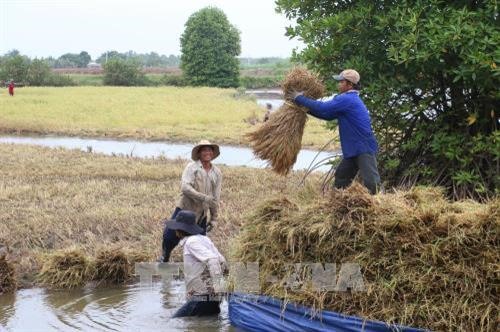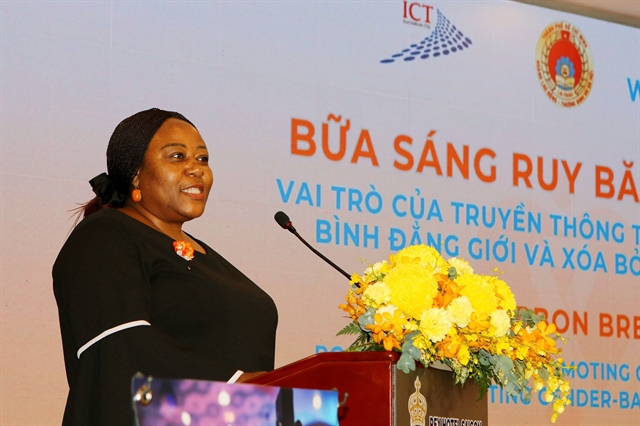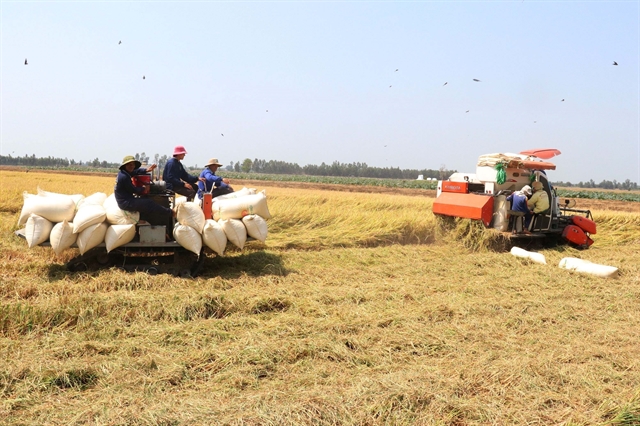 Society
Society

Farmers in Bến Tre Province’s Thạnh Phú District have earned high profits from rotating rice and shrimp cultivation in the same rice field.
 |
| Farmers in Bến Tre Province’s Thạnh Phú District harvest organic rice. – VNA/VNS Photo Công Trí |
HCM CITY — Farmers in Bến Tre Province’s Thạnh Phú District have earned high profits from rotating rice and shrimp cultivation in the same rice field.
Farmers in the coastal district grow rice in the rainy season when fresh water is available and breed “clean” shrimp or other aquatic species in the dry season when saline water intrusion occurs.
In An Nhơn Commune, which has more than 7,000ha of rice, most farmers are now growing clean rice or organic rice.
Farmers use chemical fertilisers for clean rice and organic fertilisers for organic rice, while no pesticides are used for clean rice or organic rice.
When rice fields are infected with brown planthoppers, farmers allow water to enter the fields and submerge rice plants to their tops to kill the pests.
Lê Văn Miền, who owns a 1.3ha rice field in An Nhơn’s An Hòa Hamlet, said he has grown organic rice for three years and that all of his rice is guaranteed an outlet by a company.
In 2017, he received VNĐ8,500 a kg for his rice, VNĐ1,000 higher than the market price.
Farmers face difficulties when growing organic rice for some crops as the output of organic rice fields is lower than that of clean rice fields, he said.
“However, the output of organic rice fields will increase steadily after each crop,” he said.
Farmer Lê Văn Phúc in the same hamlet said the average profit for organic rice is VNĐ3 million (US$130) per 1,000 sq.m.
Rice fields also have a lot of algae after organic rice is harvested, providing food for shrimp, fish and crabs, he said.
The cost of fertilisers used for organic rice fields is 40 per cent less than the price for clean rice fields, he said.
With the success of the rice-shrimp cultivation model in recent years, many farmers in the district who moved to other provinces to work have returned home to grow rice and shrimp.
Hồ Văn Cương, deputy chairman of the An Nhơn Commune Farmers Association, said the rate of poor households in An Nhơn had fallen to 6 per cent now compared to 30 per cent three years ago. The lives of farmers have improved, he said.
In 2016, the National Office of Intellectual Property of Việt Nam granted the collective brand name of Thạnh Phú Clean Rice in the district.
Trương Thanh Hải, head of Thạnh Phú District Agriculture and Rural Development Bureauthe Agriculture and Rural Development Bureau, said that after the collective brand name was granted, farmers’ awareness about clean rice improved.
The district has regularly organised training courses on farming techniques for clean rice, he said.
Farmers in the district have set up shrimp-rice cultivation co-operative teams to exchange information about farming techniques, diseases and prices.
The district has 25 co-operative teams as well as the Thạnh Phú Clean Rice Co-operative.
District farmers have planted 6,500ha of rice with an average yield of 4.5 tonnes per ha under the shrimp-rice cultivation model last year, according to the bureau.
The average yield of organic rice field is 300 kilo per ha more than clean rice fields, said the bureau.
Hải said besides explaining the benefits of growing organic rice to farmers, the district is trying to develop an organic shrimp cultivation model in rice fields. — VNS









